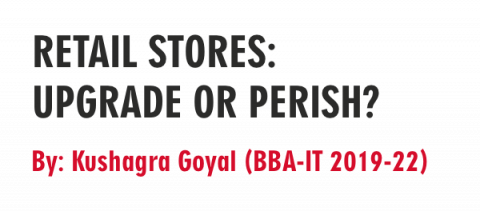
The article will elaborate on what the future holds for all retail stores, it will also give a gist of the present scenario, and where retailers stand.
Present Scenario:
In the light of the present scenario, where most brick and mortar stores have been shut out of business, or the sales are severely down. Though there was an initial increase in the purchase by customers, where most of them were trying to bulk up on the essentials – which also caused the historic toilet paper shortage in Australia – offline sales have been down ever since. The thing to consider here, is the customer’s state of mind, presently, they rarely wish to step out of the house, due to dangers of coming in contact with a positive. The traditional way in which retailing has been thrown out of the window, and as retailers eye for new methods to retain their sales rates. More than 25% of shoppers have claimed to prefer contactless payments and home delivery options, with a high percentage of people declaring not to return to brick and mortar until a vaccine for the virus is found. To add to that, the World Health Organization recently warned that the coronavirus which causes Covid-19, may become an endemic like HIV, and may never subside; WHO thus calls for mass action to counter the virus.
It may as well be taken to prove the point, that traditional marketing and retailing schemes are now facing compulsory evolution. With more and more people, fearing traditional shopping, the offline stores look at a risk of losing all business, unless they come up with innovative solutions to tackle the problem at hand. With a change being seen in the behaviour of customers, the offline stores have suffered. The online stores however, have seen something that can be termed as a flourish in the sales, considering that most users are willing to lay back, and do their shopping online. So far the increase in the online sales is an advantage to the online retailers, however, there has also been noticed a delay in the shipments, due to the increased
pressure on the supply chains. The question of the hour now is, whether companies will be able to adapt to the abruptly changing customer behaviour or will the companies perish to the change.
A key factor to note in this changing conditions, is how some industries and sectors of the markets are flourishing, while the others not so much. While the electronics sector is holding a firm 42.7%, the automobile industry is down low.
Changes in the market:
Here are the prospective changes that one can expect to see in the new post-corona market:
i. Direct delivery to customers will increase: This feature will be seen in all sectors of the market, whether it be the electronic sector, clothing sector, and even the grocery sector. On the same note, the grocery market has finally flourished online, letting go of the age old dogma of having to “feel one’s avocado”, people are finally realising that maybe online groceries are the way ahead. Or maybe, the major holdouts will now realise, what could’ve been an added bonus to their business, groceries!
ii. Payments will become contactless: this is something that is already very much in use by college students, and other people who do not like to carry around too much money in person. The online payment option will now become a necessity, as people will try and avoid using cash, which has been exchanged over countless hands. With more and more stores now allowing for the cashless payment options over checkout, this is another major change that the industry will see in the market. On the same note, other forms of mobile payments applications, in addition to the ones that the retailer’s applications, will become more mainstream, and will see a boom in the number of customers. Given the choice, people will start to prefer using online payment options. Perhaps Modi's digitization drive will finally take the turn, he expected it to.
iii. Checkout-free stores: this is a relatively new concept, where the customers are required to scan a barcode online in order to enter a store, they may then pick up whatever they want from the store, pay at the checkout and walk out of the store. The payment on the checkout is done via the help of the application for the store, by doing the same, the customer is saved from having to stand in long queues, and thus the chances of coming in contact with people is reduced. Amazon has already started to work in the same field, as they have developed their Amazon-Go experience over USA.
iv. The idea of dark stores will prosper: the traditional concept of a store, as a place where one shops is about to change. The “store” will be more of a place for the procurement of good and services for a customer, rather than a place to shop at. Retailers are usually incorporating something known as “dark stores”, which are warehouses in essence. The retailers set up their dark stores in several localities, they then take the orders from the customers, and complete the orders directly to the customers. This way, the customers fulfil their needs, without having to actually go to the market. Pickup stores will start to become increasingly common in the market, places where people simply pick up their orders, something analogous to a vending machine perhaps, that exist only to fulfil the needs of the customers, and then that is it.
v. Automation will come through in a big way: robots will start to replace mankind in industries. Automation of industries will start to take place, with more and more retailers aiming to automate their retail shops, and incorporating robots and drones in order to help the in-store customers (if any). The thing to worry about right now, is that even though the customers are placing their orders online, the person delivering those orders at their doorstep is only human, and that is one scary proposition. So, in comes Amazon, yet again saving the day, Amazon Prime Air, a new service that can deliver packages up to five pounds, contactless, and wait-for-it, by using a drone! This is the best time, when Amazon can fire its Air delivery, because this is the right market for drone delivery. Something of the same magnitude can be seen to take over traditional delivery, in the near future. We cannot say about flying cars in 2020, but we can surely see robots delivering us our packages. Now, there are pros and cons to this, while it may mean lesser human jobs, at the same time, it would mean that the business models can continue to function still. Moreover, by deploying something like automated delivery, the retail industry, as a whole, will be ready to continue functioning, if ever something like a virus re-emerges.
Conclusion:
The main problem for all retail stores currently, is to sustain these abrupt changes, and to survive in the market. While big companies will see this as an opportunity to seize the market, and hold greater shares, the smaller companies will need to keep an eye out, to persist. The retailers will have to look forward to innovative solutions to cope up for the lost business, even though the economists have predicted an extremely unstable market, there are prospects for brighter times, provided, there are innovative ways the retailers can incorporate.
“Innovation distinguishes between a leader and a follower.”
- Steve Jobs
- Steve Jobs
References:
i) https://www.forbes.com/sites/jiawertz/2018/11/28/5-trends-that-will-rede...
ii) https://www2.deloitte.com/us/en/pages/consumer-business/articles/retail-...
iii) https://retail.economictimes.indiatimes.com/news/industry/trends-that-wi...
iv) https://www.talk-business.co.uk/2019/11/11/how-the-retail-industry-has-c...
v) https://www.who.int/emergencies/diseases/novel-coronavirus-2019/situatio...



